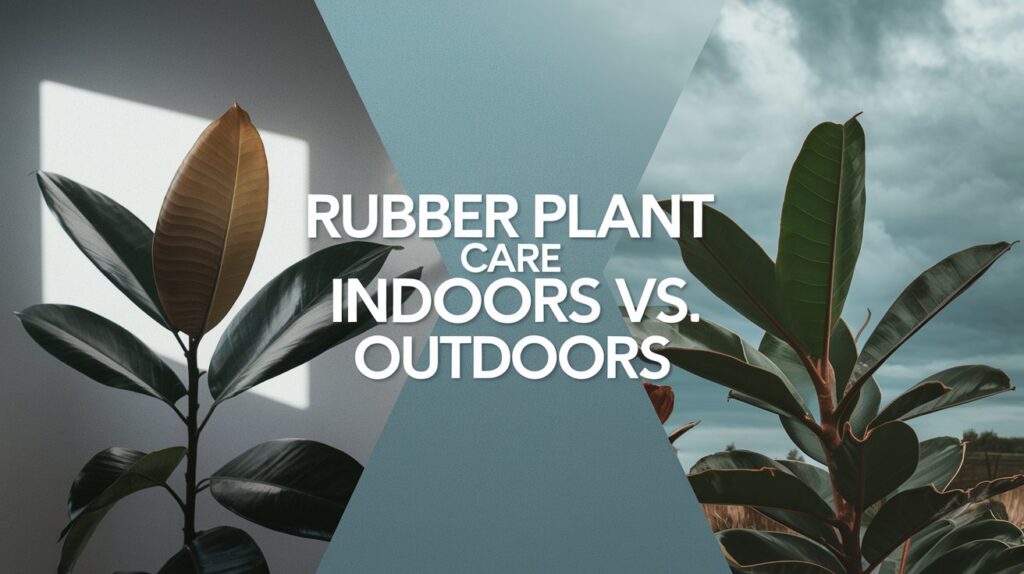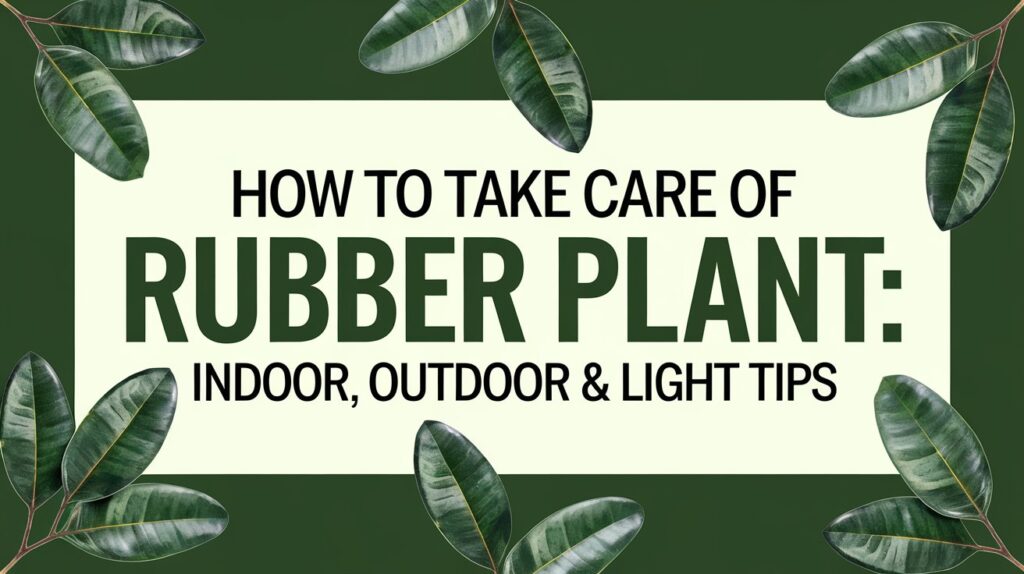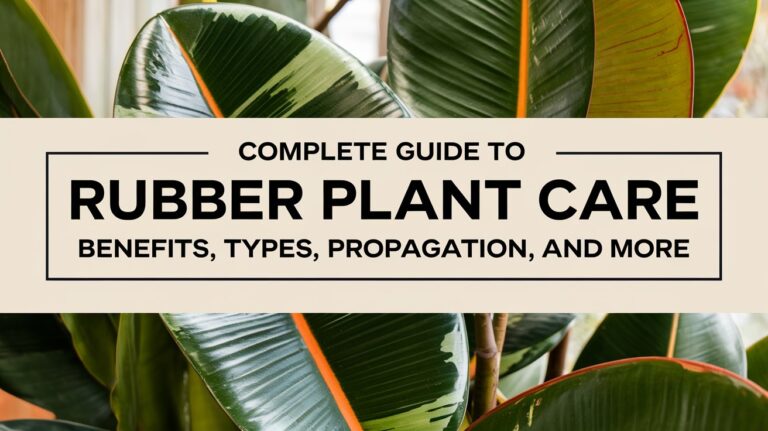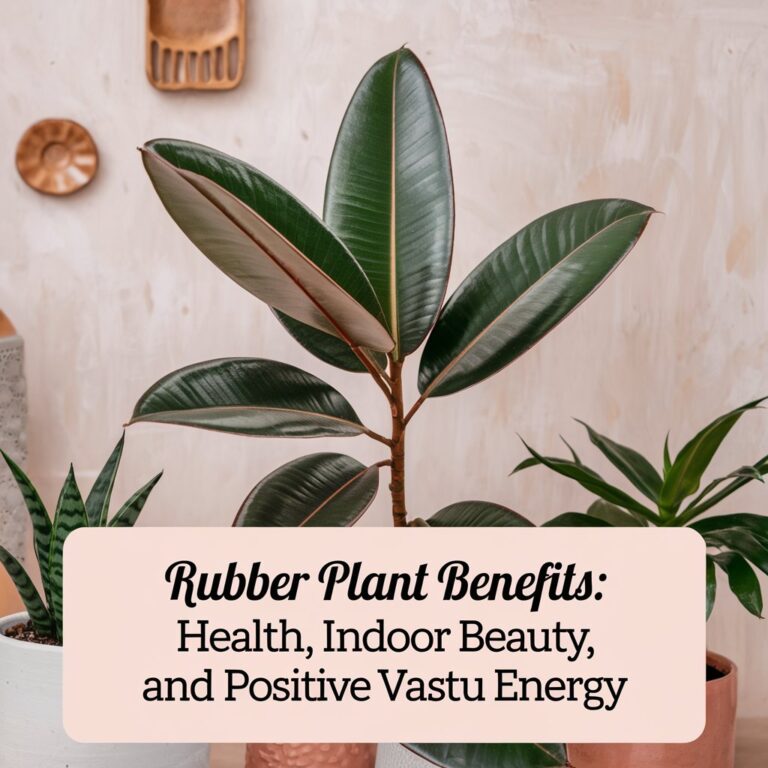The rubber plant, or Ficus elastica, has become one of my favorite plants to grow, both indoors and out. Not only does it bring a lush, vibrant green into any space, but it’s also relatively easy to care for once you understand its needs. In this guide, I’ll walk you through all the essentials of rubber plant care, from ideal lighting to seasonal care tips, including the specifics of rubber plant care indoors versus outdoors, the best soil, pruning tips, and troubleshooting common issues. Let’s dive in to keep your rubber plant looking its best!
Rubber Plant Basics and Types
What is a Rubber Plant?
The rubber plant (or rubber tree) has striking, thick leaves that come in beautiful shades of green, burgundy, and even variegated patterns. Known for being both hardy and visually appealing, it’s no wonder the rubber plant is popular as an indoor plant. A rubber plant can grow into a full-fledged tree when given the right conditions, making it a versatile option for any indoor or outdoor setting.
Different Varieties of Rubber Plants
You might recognize popular varieties like the burgundy rubber plant and the variegated rubber plant. The variegated rubber plant requires a bit more light to keep its colors vibrant, while the burgundy variety has a stunning dark hue that makes a striking indoor feature.
Rubber Plant Benefits
Rubber plants not only add beauty to your space but also help purify indoor air by removing toxins and producing fresh oxygen. This is one of the key reasons I’m a fan of rubber plant care indoors—it feels like the room is refreshed with their presence.
How to Take Care of a Rubber Plant: Essentials
Rubber Plant Care Light Requirements
Lighting is one of the most important factors for a rubber plant’s health. A bright, indirect light is ideal, as rubber plants love good light but don’t do well with intense, direct sunlight. Your plant looks greener and fuller when it has a consistent light source. If you’re growing a variegated rubber plant, it might need a bit more light to keep its colors from fading.
Rubber Plant Care Indoors vs. Outdoors

Growing rubber plants indoors has its perks, especially if you’re looking for a statement houseplant. Indoors, they’re shielded from extreme temperatures, but they do need consistent warmth.
For outdoor rubber plant care, try to place them in a spot with indirect sunlight to prevent leaf scorching, and keep them sheltered from strong winds. Growing rubber trees outdoors can give them the space they need to grow bigger and stronger, especially in warmer climates.
Indoor Rubber Plant Care Tips
How to Take Care of a Rubber Plant Indoors
If you’re keeping a rubber plant indoors, focus on finding a spot with bright, indirect light. The temperature should be above 60°F, as rubber plants don’t handle cold well. I’ve found that rubber plants thrive near east or north-facing windows where they get softer morning light.
Indoor Variegated Rubber Plant Care
The variegated rubber plant is a bit more light-hungry, needing brighter, indirect light to maintain its leaf colors. When grown indoors, make sure it’s near a well-lit window, but not in the direct line of sunlight.
Rubber Plant Care in Winter
Winter can be challenging for a rubber plant because they’re sensitive to temperature drops. I keep mine away from drafty windows and reduce watering. The trick is to let the topsoil dry before watering during winter.
Rubber Plant Care for Outdoor Growth
Outdoor Rubber Plant Care Tips
For those of you keeping rubber plants outdoors, find a spot with indirect sunlight. Outdoors, rubber plants can be more resilient but still need protection from intense heat and cold. Placing them under a tree canopy or shaded patio can work well. Just remember to bring them indoors if the temperature drops below 60°F.
How to Care for a Rubber Tree Plant in Outdoor Conditions
When grown outside, rubber tree plants will flourish if given a bit of space to expand. They’ll need a well-draining soil mix that retains moisture but prevents root rot. Outdoor rubber trees can get quite tall, so make sure they’re not crowded by other plants.
Watering and Soil Needs for Rubber Plants
How to Water Rubber Plants
One of the trickiest parts of rubber plant care is getting the watering just right. Rubber plants prefer to dry out a bit between waterings, so water when the top inch of soil feels dry. Overwatering can lead to root rot, which is common in rubber plants if the soil doesn’t drain well.
Best Soil for Rubber Plant Growth
Using a soil mix that drains well is crucial. I recommend a mix with a good balance of peat, pine bark, and perlite, which helps retain moisture without waterlogging. Rubber plants don’t like heavy, dense soil, so keep it light and airy.
Pruning and Maintenance Tips
Rubber Plant Care Pruning Techniques
Pruning rubber plants is a great way to encourage fuller growth and shape the plant to your liking. Trim back the leggy branches and remove any yellow or damaged leaves. This will not only make your plant look better but also keep it healthy.
How to Manage Rubber Plant Leaf Issues
If you notice issues like yellowing, browning, or drooping leaves, it could be a sign of overwatering, poor light, or a lack of nutrients. Proper pruning and regular checks on watering can help prevent these issues. I’ve found that a well-cared-for rubber plant rarely has leaf problems, so with a bit of attention, they’ll stay in great shape.
Additional Tips and FAQs on Rubber Plant Care
Can Rubber Plants Survive Low Light?
Rubber plants can tolerate lower light but won’t thrive in it. If you’re in a low-light area, consider supplementing with a grow light or placing the plant closer to a window.
How to Care for Rubber Plant Cuttings
Rubber plants are relatively easy to propagate from cuttings. Take a healthy cutting, place it in water or soil, and wait for roots to grow. This is a great way to share your rubber plant or expand your collection.
Conclusion
Caring for a rubber plant is a rewarding experience that doesn’t take much effort once you know what to do. From watering tips to ideal light levels and troubleshooting leaf issues, this guide gives you the basics to enjoy a thriving rubber plant, whether indoors or outdoors.
For more on rubber plants and related care tips, check out my post on a detailed guide to rubber plant.
Hi, I’m Pritesh, the heart and hands behind Roots & Earth. My love for plants started when I was just 5 years old, planting trees alongside my grandfather. Those early experiences in the garden left a lasting impression, shaping my deep connection to nature and sparking a lifelong passion for nurturing green spaces.
With an MBA under my belt, I’ve blended my business acumen with my love for gardening, creating Roots & Earth as a way to share my knowledge and inspire others. When I’m not working in my own home garden, you’ll find me traveling to the mountains—my favorite getaway for reconnecting with the natural world.
At Roots & Earth, I’m here to guide you on your gardening journey, whether you’re a seasoned green thumb or just starting out. Together, let’s cultivate beautiful, thriving spaces that enrich our lives and the earth.




